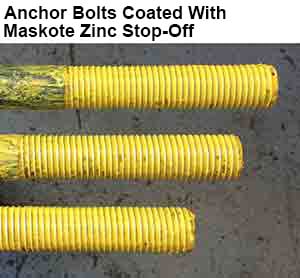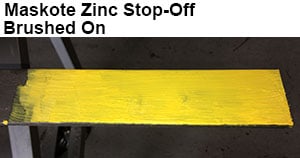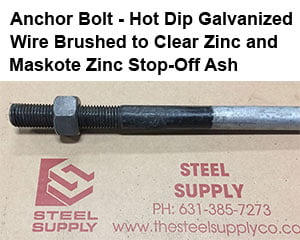Stops Zinc from adhering to selected areas of steel during the Hot Dip Galvanizing process.
Occasionally a steel fabricator will be confronted with the requirement to fabricate steel and have it Hot Dip Galvanized yet leave some areas un-coated. There are a variety of reasons for this;
- Areas that will be welded during steel erection
- Areas that require studs welded in the field
- Anchor Bolts where either the threads or the embed should remain clear
- Internal threads that are difficult to clear once zinc is solidified.
The best and most reliable system we have found is coating the desired areas with Maskote Zinc Stop-Off. This is a heavy viscous paint designed to survive all the preparation processes applied by the galvanizer and still be present during galvanizing. The object of Hot Dip Galvanizing is to have the Zinc coating form a molecular bond with the steel substrate. By remaining present throughout the process Zinc Stop-Off prohibits the zinc from bonding.
According to ASTM A-123 /  A-153 specifications hot dip galvanizing is a 4 step process. Each step is known as a “Bath.” The first bath is known as Degreasing, in a hot alkali solution. The second, Pickling, is heated sulfuric acid or ambient temperature hydrochloric acid. The third is Fluxing which employs a zinc ammonium chloride solution. Between each bath there is normally a rinsing process. Most coatings could not withstand being immersed in these acids and solutions but that is what makes Maskote Zinc Stop-Off as effective as it is.
A-153 specifications hot dip galvanizing is a 4 step process. Each step is known as a “Bath.” The first bath is known as Degreasing, in a hot alkali solution. The second, Pickling, is heated sulfuric acid or ambient temperature hydrochloric acid. The third is Fluxing which employs a zinc ammonium chloride solution. Between each bath there is normally a rinsing process. Most coatings could not withstand being immersed in these acids and solutions but that is what makes Maskote Zinc Stop-Off as effective as it is.
It is important to understand which type of surface preparation will be used by the galvanizer. The second of the baths mentioned above, Pickling, is intended to remove mill scale and iron oxides from the steel surface. Maskote Zinc Stop-Off is designed to withstand the heated sulfuric acid bath method of Pickling. Another way a Galvanizer may choose to remove the mill scale is with abrasive cleaning. This involves sand blasting, glass bead blasting or metallic shot blasting. Any of these abrasive processes will erode the Zinc Stop-Off coating and render it ineffective.
Maskote Zinc Stop-Off starts off as a bright yellow coating. When the final step is reached, the immersion into the molten Zinc, the thick Maskote coating is still in place on the fabricated steel. Its function is to block the molten Zinc from bonding with the steel. Because the zinc cannot bond it will either run off or may embed itself in the coating. The yellow coating will now have oxidized and be a thick, black residue.
Once removed from the Zinc kettle and cooled to ambient temperature the residual black ash crust will become brittle. It is easily removed with a wire brush, wire wheel or any abrasive that wears through the coating. The original application of the coating will now be apparent. Where the Zinc Stop-Off coating adhered to the steel surface the ash will fall away and the steel surface will be bare again.
Examples of projects requiring Maskote Zinc Stop-Off can range from DOT and Bridge construction where there will be Hot Dip Galvanized steel members that require field welding and are then embedded in concrete. Also steel road plates that have threaded holes for the lifting hooks. If these plates are being galvanized zinc will settle in the internal threads and re-tapping will be required. Internal threads present a difficult situation in that they are tapped using some type of cutting fluid which may be oil or water based. Each will leave a different residue, along with shavings from the thread cutting. Zinc Stop-Off does prevent this, but to adhere to the steel and prevent any zinc from clogging the internal threads it is important all the shavings and residue film be cleaned away. The cleaning system that preforms best in these cases is MEK (Methyl Ethyl Ketone) applied with a cylindrical brush.
galvanized zinc will settle in the internal threads and re-tapping will be required. Internal threads present a difficult situation in that they are tapped using some type of cutting fluid which may be oil or water based. Each will leave a different residue, along with shavings from the thread cutting. Zinc Stop-Off does prevent this, but to adhere to the steel and prevent any zinc from clogging the internal threads it is important all the shavings and residue film be cleaned away. The cleaning system that preforms best in these cases is MEK (Methyl Ethyl Ketone) applied with a cylindrical brush.




